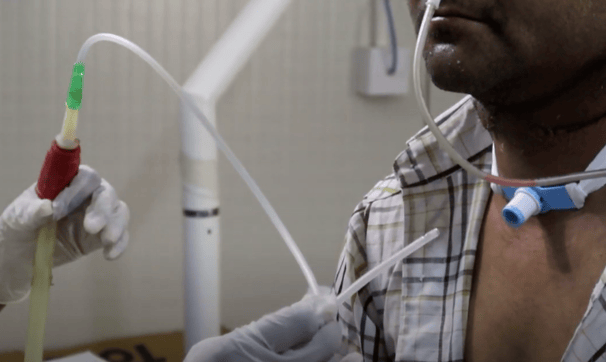Tracheostomy Tube Care
AFTER SURGERY


A tracheostomy is an artificial opening or hole into the neck that the patient breathes into directly. A plastic tube called a tracheostomy tube is placed in it to keep it open.
A ribbon is tied around the neck to keep the tube in place. Alternatively, it may also be secured using stitches.



1. Before You Leave the Hospital
Before discharge, healthcare providers will teach you how to:
Clean, replace, and suction the tracheostomy tube.
Keep the air you breathe moist.
Clean the tracheostomy site with water and mild soap.
Change the dressing around the hole.
2. Humidity
The nose and mouth naturally warm and humidify the air we breathe. Since the patient breathes through a tracheostomy tube directly, we must replace this humidification. Without added moisture, secretions in the throat may become thick and hard to cough out, making it difficult to breathe.
To maintain moisture and help clear secretions:
Ensure that the patient drinks plenty of fluids to keep secretions thin—about 10 glasses of water/fluids daily.
Use a moistened tracheostomy bib to cover the tube at all times.
3. How to Suction the Tracheostomy Tube
Your doctor or nurse will teach you how to suction the tube before discharge. The tube should be suctioned every 2-3 hours, or more frequently if advised.
Equipment Required:
Suction machine (consult your doctor/nurse on where to purchase it before discharge).
Suction catheter.
A bowl or large cup filled with water.
2 to 4 dry gauze pads.
A clean, dry cloth.
Instructions:
Wash your hands thoroughly with soap and water.
Connect the suction catheter to the suction machine’s plastic tubing.
Turn on the suction machine.
Pinch the suction catheter between your thumb and pointer finger to block the suction.
Ask the patient to cough deeply to bring up secretions.
While keeping the suction catheter pinched, insert it about 3-5 inches (8-13 cm) into the tracheostomy tube.
Un-pinch the suction catheter to start suctioning. Do not keep the catheter in the tube for more than 10 seconds, as it can cause shortness of breath.
Use a rotating motion while pulling the catheter out of the tracheostomy tube. This helps remove secretions from all sides of the tube.
Do not insert the catheter more than 3 times during a suction period.
After removing the catheter, ask the patient to breathe deeply.
Wipe the suction catheter with dry gauze and rinse it by suctioning water through it.
Repeat the process if needed. If you have to suction more than 2-3 times, allow for a short rest before repeating.
4. Post-Suction Care
Clean the suction catheter and plastic tubing. Wipe the outside and suction water through the inside to rinse them.
Disconnect the suction catheter from the plastic tubing.
Place the catheter on a clean, dry cloth or paper towel.
At home, empty the suction machine’s canister into the toilet (not the sink, as it may clog drains). In the hospital, a staff member will handle this.
Change the suction catheter once a week at home or sooner if it becomes dirty or clogged.
Clean the suction machine canister with soap and water as needed.
5. When to Seek Medical Help
Vomiting: If the patient vomits, cover the tracheostomy tube with a towel or cloth to prevent vomit from entering the airway. If any vomit enters the tube, suction immediately.
Thick Secretions: If secretions become too thick to cough out or suction, increase chest physiotherapy, steam inhalation, and have the patient drink more fluids.
Difficulty Breathing: A plugged or partially plugged tracheostomy tube can make it difficult to breathe, often due to a buildup of secretions. If this happens:
Ask the patient to cough hard.
Try suctioning.
If available, squirt normal saline into the tracheostomy tube with a syringe to help loosen the blockage.
Suction again if necessary.
If the patient continues to have difficulty breathing, go to the hospital immediately.
6. When to Call Your Doctor
Fever of 101°F (38°C) or higher, or fever with chills.
Red or swollen skin around the stoma.
Bleeding or drainage from the tracheostomy hole.
Cough or shortness of breath, even after suctioning the tube.
More mucus than usual, or mucus that changes from clear to yellow, green, or brown.
Mucus with a bad smell.
For more detailed information, refer to the following:
Read More on Caring for Your Tracheostomy


